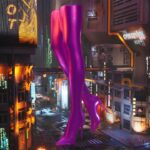I am one of the medicines of the Nlaka’pamux people, of the people living on Seabird Island Band. Some old heads put a little bit of me in their shoes, or make a little tea with me, once a day when there is a virus afoot, for protection, and cynics say that is superstition – not science. I have no human form – though once, we walked like people do. These are stories we hear less now.
When the people harvest bark in the spring – they will do it six-feet from one another, smiling to close the distance. They will make bracelets and weave crowns and headbands and capes to celebrate name-giving and graduations and potlatch, and all the good things coming to the First People: The people who offer before they take, who never forget the medicines, whose practices are called superstitions by their own.
Trees still walk, just slower, please tell them – there is a science to it. I promise.
There was a little girl, this time last year, learning with her auntie how to pick a bough.
“You have to put down tobacco and say thank you and pray before you take something from the tree.”
The girl smiled. She was embarrassed to be stumbling as she prayed, as she said thank you to me – and I wanted to say, thank you for carrying on this tradition of wellbeing, of collecting medicine for your auntie, who will put the bough above her door to keep spirits away.
The auntie does not know if the tradition is Nlaka’pamux or Christian, given what white people did to her family, to her culture, to her soul – she does not care, because it is what her grandmother taught her to do, and it is Nlaka’pamux now.
These are matriarch hands on me. Generations of power – of offering – of celebration, and of pain.
A burial is called a planting where we are. This auntie, her mother was planted in a cedar box, carved by one of the men on Seabird – who would not take any money.
My fear, when I saw the beauty of the box, was that it would someday be uncovered by an anthropologist, who would find the mother’s bone’s remarkable – the box, remarkable, and then nobody would rest – it would all be in some Nlaka’pamux exhibit in Chicago or New York.
But today, she rests.
I am asleep for now, too. I cannot say in my waking hours, I am more lively than I am now – there is spirit in quietude – in receiving and watching. Stillness and observation can inspire. The diamondback rattler, the moment – she was still, before she turned a corner – inspired a girl in her weaving to make the first diamond pattern in a basket. We regale each other and fit together in simple ways. This interconnectedness has worked a long time now.
Forgive me, if I am too relational – to the people I have known for thousands of years. I could tell you about cherry bark or canary grass, how we mingle in baskets to bring water – or I could describe my being verdant, and rusted in the dull reaches of myself. How you cannot run your fingers against the grain of my outer bark or bough. It hurts too much. Elders say, some things are worth hurting for, others are not. Common sense is taught doing practical things, like harvesting my roots for different kinds of baskets – different kinds of legacies I hope will one day not be museum exhibits, but home decor, where kids ask, what is that, auntie?
And someone says: “Your lifeblood. Our whole culture is above the fireplace. You want to go outside, and say thank you?”
SOURCE: AL JAZEERA NEWS
https://www.aljazeera.com/indepth/features/earth-speak-cedar-tree-200329135742806.html
AUTHOR: Terese Marie Mailhot
Terese Marie Mailhot is from Seabird Island Band and is New York Times bestselling author of Heart Berries: A Memoir.
IMAGE: Coastal temperate rainforest in British Columbia, Canada [Getty Images]





